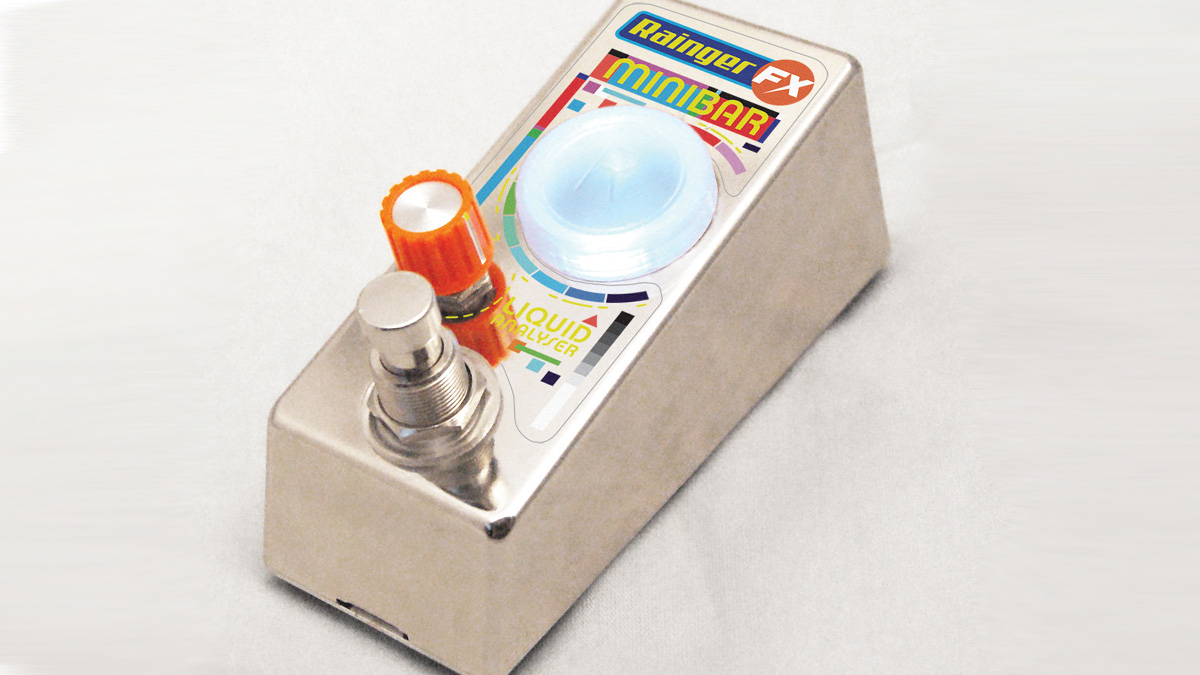GuitarPlayer Verdict
If you love your drive and fuzz pedals so much that you'd want to share your drink with them, this experimental yet practical and musical little dirt box is just the thing. It's no gimmick. The tones are totally legit.
Pros
- +
Fantastic, fun way to create an endless variety of cool, gritty tones.
Cons
- -
None.
You can trust Guitar Player.
At NAMM 2020, Rainger unveiled a drive/distortion/fuzz mini-pedal that changed its sound depending on which liquid you put into a plastic container embedded in the chassis.
Reactions ranged from “What?!” to insert-your-laughable-liquid-joke-here. That was then, but now the time has come to check out the seriousness of this intriguing stomp box. Some of the Mini Bar Liquid Analyser’s appeal is its off-the-charts cool factor.
Carnival colors plaster the small casing, and the single output knob is bright orange. The plastic liquid container lights up when the effect is engaged, and a small green light under the fluid flashes when you play.
So far, so fun, but how does it sound? Well, if you don’t put any liquid in it, it doesn’t sound at all. However, add just enough fluid to cover the zinc-plated contacts at the bottom of the container and the Mini Bar can spit out some fabulous forms of grit.
The amount and tonal characteristics of the dirt vary greatly or subtly, depending on the chosen liquid. I began with basic tap water, which produced low-distortion gain with plenty of midrange push, like a vintage treble booster.
Thanks to Covid, I had some beard oil on hand, so I tried that next, and the difference was striking, with much more gain, volume and, appropriately, a fuzzier sound. Being a Bloody Mary fan, I have a ready supply of Worcester and Tabasco sauce. The former featured low volume and a very dark tone — too clean for distortion, but possibly good for an EQ effect — while the latter produced a nice warm drive.
Isopropyl alcohol served up lots of thick, Fuzz Face–style gain, brighter than that of the beard oil. Hydrogen peroxide offered lower gain and a tone focused in the low midrange, perfect for fattening an already broken-up amp or pedal.
All the latest guitar news, interviews, lessons, reviews, deals and more, direct to your inbox!
Between experiments, I cleaned the previous liquid out with a damp paper towel. If you don’t thoroughly clean the container between fillings you might get an adulterated blend, though you may want to mix liquids on purpose for even more tonal variations. So, how does it work?
According to David Rainger, the secret is the number of free ions in the liquid of choice. Water has many and so it conducts well, producing low distortion. Alcohol has very few and creates high distortion. Olive oil apparently has none, resulting in the same silence as no liquid at all. In addition, the Minibar has a band-pass filter that adjusts according to the opacity of the liquid.
This pedal might easily have been a novelty item to play with during pandemic boredom, rather than a pro device, but the results frequently sound great. I was able to get everything from raging rock fuzz, huge on its own into a clean amp, to more subtle tone-shaping dirt that did marvelous things to slightly driven amps or pedals.
Ultimately, the Mini Bar lets you design the dirt that works for you. And, unlike other pedals, when you get bored with that sound, you can raid the medicine or liquor cabinet for inspiration (for you and the pedal). For sound, innovation and pure fun, the Mini Bar gets an Editors’ Pick Award.
Specifications
- PRICE: $149 street
- CONTROLS: Volume
- FEATURES: Plastic container that holds various liquids to shape sound
- BUILT: Assembled in United Kingdom
- CONTACT: Rainger FX

